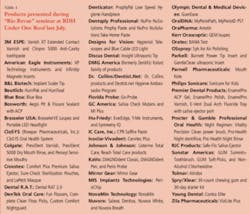The risk is not trying
Seminar at RDH Under One Roof reviewed exhibitors’ products
Patti DiGangi, RDH, BS
The RDH Under One Roof 2009 conference in Las Vegas last July was once again a rousing success. Over 1,000 hygienists, many funding their own way, were in attendance. For the seminar titled, “Rio Revue: New and Innovative Products 2009,” there was sitting-on-the-floor and standing-out-the-door room only. The audience was challenged to create the future as early interventionists by becoming risk factor managers.
Risk factor management in a pure dental hygiene model can be defined as discovering risk of breakdown, diagnosing early caries, soft tissue changes, oral cancer, and periodontal disease, and treating those infections before they cause damage. It is also managing injury risk, ergonomic risk, biofilm risk, dry mouth risk, visual risk, allergy risk, infection and reinfection risk, pain risk, cross contamination risk, and missed diagnosis risk (see chart at right). Each product presented during the two-hour program helps professionals manage risk.
Forty-five companies with 77 new/innovative products were reviewed during a fast-paced session (see Table 1 for list of all of the products reviewed). Each product assists professionals in managing at least three or more areas of risk. Participants in the program were not passively sitting there in the cramped room; they were charged with two tasks during the session. The first was to vote for their top ten new/innovative products. The results of voting were tallied two ways. First was overall point total and second for the total number of votes in Top Ten (see Table 2). The voting was very close with every company receiving double and triple digit votes.
The second task for audience members was participation in a focus group as a key opinion leaders. Dental manufacturers highly value the thoughts and opinions of professionals. Each company designed its own focus group activity. Philips Sonicare invited every participant to be part of their practice based study. The contributions of each of these key opinion leaders will influence the direction and future of our profession.
Cell phones are replaced every two to three years, yet clinical dental hygiene often is practiced the same way as it has been for the past 20 to 30 years. With a myriad of new products brought to market to help manage risk, the purchase and routine use of these innovations is often very slow.
If you could equip and supply your clinical practice exactly as you believe it should be, what would it look like? Why don’t you have it? Reasons can range from:
- There is no time
- The dentist won’t let me
- The assistant won’t order it
- It’s too expensive or the current easy excuse — the economy
- You have tried and tried in the past and it never has worked.
We may be suffering from Baby Elephant Syndrome (see related article). Our own self-limiting beliefs can hold us back.
Successful leaders have a positive attitude about themselves, which causes others to have confidence. They have an attitude of “if at first you don’t succeed, don’t just try again; try another way” until they find success. Every dental hygienist is a leader with the potential to create positive change and grow their practice and profession. The dental industry is there to help. Leadership skills can be learned through courses at RDH Under One Roof, articles in PennWell publications, webinars, participation in our professional association, ADHA (www.adha.org), as well as other opportunities such as those provided by CareerFusion. At the annual retreat in January, CareerFusion attendees discovered ways to use existing education and expertise in new and exciting ways by exploring opportunities to fuse passion with career. Several CareerFusion corporate partners announced scholarship opportunities for the 2010 retreat during the Rio Revue session (find scholarship details at www.careerfusion.net).
Recently, Cathy Seckman, Shirley Gutkowski, and I wrote about the need to spread a virus (August 2009 issue of RDH) — not the swine flu virus but rather the “change virus,” infecting dental hygienists to become early interventionists. Whatever one feels about the current healthcare reform debate, the one area appearing to have nearly universal agreement is the cost savings that can be gained through prevention and wellness. Dental hygienists are the professionals best suited to lead the risk-based early intervention movement and spread the virus within their own offices.
Author’s note: Many thanks to each company’s contributions and advance planning to make this course successful. Thank you to the CareerFusion alumni for their support. And a very special thank-you to Shirley Gutkowski for the graphic design and assistance. And, finally, thank you to PennWell for this opportunity. Success is a team effort.
About the Author
Patti DiGangi, RDH, BS, is a speaker, author, practicing dental hygiene clinician, and director of CareerFusion (www.careerfusion.net) a retreat providing personalized training in all facets of career evolution. She can be contacted through her Web site at www.pdigangi.com.
Baby Elephant Syndrome
An adult elephant can easily uproot huge trees with its trunk — yet, elephants often are tethered by only a small rope and wooden stake. Why do the elephants not escape? When an elephant living in captivity is still a baby, it is tied to a tree with a strong chain every night. Because it is the nature of elephants to roam free, the baby elephant instinctively tries with all its might to break the chain. But it isn’t yet strong enough to do so. Realizing its efforts are of no use, it finally gives up and stops struggling. After the baby elephant tries and fails many times, it will never try again for the rest of its life.
Later, when the elephant is fully grown, it can be tied to a small stake with a thin rope. Although it could then easily free itself by uprooting the tree or breaking the rope, its mind has been conditioned by its prior experiences, and it doesn’t make the slightest attempt to break free. The powerfully gigantic, very intelligent elephant has limited its present abilities based on the limitations of the past — Baby Elephant Syndrome. Human beings/dental hygienists can be exactly like the elephant except for one thing — we can choose not to accept the false boundaries and limitations of our past.




